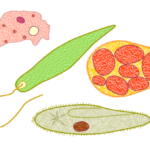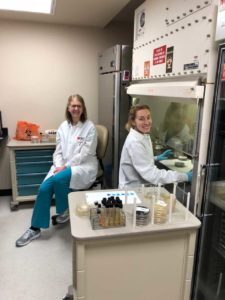Pharm to Exam Table: Clinical Pharmacology/Antimicrobial Updates – Trogarzo® (ibalizumab-uiyk), a new monoclonal antibody treatment approved for multi-drug resistant HIV-1
On March 6th 2018, the Food and Drug Administration approved a new monoclonal antibody called ibalizumab-uiyk, marketed under the tradename Trogarzo®. Ibalizumab-uiyk (IBA) is an intravenous treatment administered every two weeks. It is intended for use in combination with other antiretrovirals (in an optimized background regimen), for the treatment of HIV-1 infection in heavily treatment-experienced adults with multidrug resistant HIV-1 infection, failing their current antiretroviral regimen.(1)
 IBA is a humanized long-acting IgG4 monoclonal antibody that prevents attachment of the HIV-1 molecule to CD4+ T cells by changing the conformation of the CD4+ T cell receptor while preserving the function of the cell. These functions classify IBA as an entry inhibitor.(1,3,4) Other previous entry inhibitors are enfurvitide (fusion inhibitor) and maraviroc (CCR5 antagonist).
IBA is a humanized long-acting IgG4 monoclonal antibody that prevents attachment of the HIV-1 molecule to CD4+ T cells by changing the conformation of the CD4+ T cell receptor while preserving the function of the cell. These functions classify IBA as an entry inhibitor.(1,3,4) Other previous entry inhibitors are enfurvitide (fusion inhibitor) and maraviroc (CCR5 antagonist). 
The FDA approval was based on results of study TMB-301 (N=40), an open-label study that investigated the antiviral activity and safety of IBA when administered with an optimized background regimen (OBR) in treatment-experienced patients with multi-drug resistant HIV-1. The study followed patients prospectively over 24 weeks after dosing them with IBA and their OBR. At day 14, 83% of patients achieved at least a 0.5 log10 (roughly 70%) viral load reduction from baseline seven days after receiving the IBA loading dose. By week 25, the mean change from baseline viral load was -1.6 log10 with 55% of participants having a ≥1 log10 reduction in viral load. The most common drug-related adverse reactions (incidence ≥ 5%) were diarrhea (8%), dizziness (8%), nausea (5%) and rash (5%). Serious adverse events were reported in 23% (9/40) of participants and of these only one was considered drug-related (immune reconstitution inflammatory syndrome, IRIS).(1,2,4)
IBA is the first monoclonal antibody entry inhibitor approved for HIV infection. Given its unique properties, tolerable safety profile, lack of drug-drug interactions or antiretroviral cross-resistance, IBA offers an attractive antiretroviral option for adjunct treatment of multi-drug resistant HIV-1 infection in combination with an Optimized Background Regimen.
References
1 Trogarzo ® [package insert]. TaiMed Biologics USA Corp., Irvine, California; 2018
2 TaiMed Biologics Inc. Ibalizumab Plus Optimized Background Regimen in Patient With Multi-Drug Resistant HIV. Available from: https://clinicaltrials.gov/ct2/show/NCT02475629
3 Iacob S A, Iacob D G. Ibalizumab targeting CD4 receptors, an emerging molecule in HIV therapy[J]. Frontiers in microbiology, 2017, 8: 2323.
4 Lewis S et al. Long-acting ibalizumab in patients with multi-drug resistant hiv-1: a 24-week study. CROI, 2017 (Poster).
Images courtesy the Department of Health and Human Services AidsInfo website HIV/AIDS glossary on CCR5 Antagonists and Fusion Inhibitors.
Thanks to Chao Fu, UNMC PharmD candidate 2018 for providing concept for content.




 If you work in an office at all, chances are you have come into contact with an Administrative Professional. The impact of an Administrative Professional on their office team has been compared to glue or paperclips that keep the office together. Our Administrative Professionals are an integral part of our group here at UNMC ID. Sure, they help with things like setting up meetings, lectures, organizing receipts and appointments; but the best part of our people here are the intangibles. These individuals are so well integrated into our daily routines that it can be easy to take them for granted, but if they are absent for some reason, it becomes more obvious to us how much we rely on them for our days to go smoothly. In addition to the administrative duties, our Administrative Professionals are like family. They routinely visit our faculty and fellows to say hi, to check in with us to make sure we are staying sane, help new faculty and staff get acclimated, organize collections of food and money to help our colleagues in the division during difficult
If you work in an office at all, chances are you have come into contact with an Administrative Professional. The impact of an Administrative Professional on their office team has been compared to glue or paperclips that keep the office together. Our Administrative Professionals are an integral part of our group here at UNMC ID. Sure, they help with things like setting up meetings, lectures, organizing receipts and appointments; but the best part of our people here are the intangibles. These individuals are so well integrated into our daily routines that it can be easy to take them for granted, but if they are absent for some reason, it becomes more obvious to us how much we rely on them for our days to go smoothly. In addition to the administrative duties, our Administrative Professionals are like family. They routinely visit our faculty and fellows to say hi, to check in with us to make sure we are staying sane, help new faculty and staff get acclimated, organize collections of food and money to help our colleagues in the division during difficult  times, celebrate our birthdays and achievements, and give hugs or hold our hands when we have losses or disappointments. They do all of these things without ever asking for recognition.
times, celebrate our birthdays and achievements, and give hugs or hold our hands when we have losses or disappointments. They do all of these things without ever asking for recognition. What is meningitis?
What is meningitis?









Recent Comments